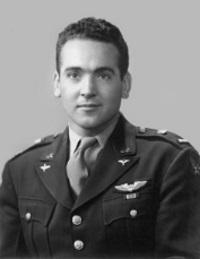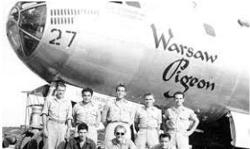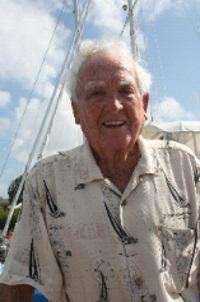Decorated B-29 Pilot Described As A Humble Man Of Extraordinary Achievements
By Bruce Brandon
There is a changing of the guard. Those brave men and women — yes women WASPs were critical in the war effort delivering airplanes where they were needed and served valiantly in the medical corps — fought and survived WWII, are leaving us at an alarming rate. One aviator whose passing should not go unnoticed is Colonel Charles L. “Chip” Collins, who died last month at the age of 95.

Chip was a self-made legend, born and raised in Pewee Valley, Kentucky, an extremely small town just northeast of Louisville. He got the “flying bug” when he was five years old and saw an old World War I airplane in a field and was allowed to touch it. Working odd jobs to get flying time, Chip soloed at age 16 and quickly got his private certificate. His “lucky break” came with the advent of WWII. He was a gung-ho young man who hated fascism and was too impatient to wait for the U.S. to enter the war, so he enlisted in Royal Canadian Air Force (RCAF).
He went to Canada where he trained as a fighter pilot. Before he could be sent overseas, the U.S entered the war. He was given the choice to stay in the RCAF or return and fight under the American flag. He came home and joined U.S. Army Air Corps. Because of his extraordinary skill and experience he was initially made a flight instructor. From there he went to B-17s and then to the B-29s. It was in the B-29 that Chip would do his fighting.
The B-29 bombing of Japan is a forgotten part of WWII and often those men who fought there are under-appreciated. The B-29 Superfortress, whose development and production cost more than the Manhattan Project, was the state-of-the-art airplane. It cost $670,000 (about $10.15 million in today’s dollars), and nearly 4,000 were produced. It was the B-2 of its time with Wright Cyclone R-3350-23 engines that produced 2200 hp each that allowed for a service ceiling in excess of 33,600 ft. (when they were all working properly which was often not the case). The “maximum overload” gross weight was 135,500 lbs. and its cruise speed was only 220 mph with a maximum range cruise speed of 185-190 mph which was flown on bombing missions. During the bombing of Japan from June 1944, 500 airplanes were lost along with 3,000 airmen.
It was initially thought that the B-29 would be used in the European theater but later decided that its long range was best suited for the Pacific. Initially based in China the B-29 conducted limited bombing but the logistics of obtaining fuel and munitions “over the hump” proved too difficult. After the Marines captured Guam and Tinian it was decided to base the B-29s there, where the logistics of fuel and munitions were greatly simplified. These were the ideal bases to take the war to mainland Japan. Their location required the crews to fly missions that were 1500 miles each way, a very long journey for an airplane that cruised only 190 mph (best long range cruise speed). These 1500 mile legs were extremely hazardous. The B-29 crews faced not only the Japanese AA/fighter cover, but also the danger of the extremely long over water missions in an airplane that often suffered battle damage and had engines that were less than optimally reliable. Little appreciated by Americans (especially
those who have not read Unbroken) is that the Pacific is an enormous ocean and the consequences of going down over the ocean and being lost at sea, or being shot down over Japan, were truly horrendous. The prisoner mortality rate in Japanese POW camps was roughly 9 times that of Nazi Germany’s.
One of the great things about being in the military, even today, it that responsibility is quickly bestowed on young men (and now women) at very early stages of their service, even more so during war time. Chip was a 26 year old Captain when he assumed command of his B-29, the “Warsaw Pigeon”, named after his then wife, of Polish heritage, who was nicknamed Pigeon.
He was the “old man,” He picked up the Warsaw Pigeon new from the factory and flew it to Tinian and was among the first to bomb Japan from the island.
It was 1500 miles to Japan with no alternate airfields available in case of battle damage. Consequently many airplanes were forced to ditch in the Pacific Ocean, a vast expanse for search and rescue to cover. It wasn’t at all unusual to incur flak damage. Sadly many crews were never returned.
Another problem of having no airfields closer to Japan was that P-51s didn’t have the range to escort the B-29s to Japan. They were on their own. While the Japanese Air Force had been greatly diminished, it still presented a significant threat to unescorted B-29s.
Because of the 3,000 mile round trip over water without fighter protection, the casualty rates on some mission reached 30%. Obviously unacceptable.
When the U.S. Marines took Iwo Jima, the primary benefit was that it allowed for an air base to be established. Iwo Jima is halfway between Tinian and Japan. The stated reason for the taking of Iwo Jima was that it would allow P-51s to escort B-29s on Japan bombing missions. (After the horrendous casualties inflicted on the Marines, almost 1/3 of the total suffered during the entire war, the rationale for capturing of Iwo Jima changed). The theory was that closer proximity allowed P-51s to escort the B-29s all the way to the target. It also provided an emergency landing field for stricken B-29s.
The Warsaw Pigeon was the second B-29 to use this strip, when it suffered battle damage on a bombing mission and couldn’t make it back to Tinian. When Chip landed, the Marines hadn’t completely taken the airfield. The Japanese, at the departure end of the runway were firing at Chip as he rolled out and hastily taxied to the safer end of the runway.
One problem the B-29s had was that the U.S. did not know about, much less understand, the jet stream. Chip remembered the time his navigator called up and said “hey skipper, the radar is broken.” Chip went to take a look and indeed the radar was showing them travelling backwards! Unbeknownst to them, they were caught head on against the jet stream. Fortunately, they flew out of it and completed their mission.

The B-29 was designed to be a high altitude bomber which is how it was initially being employed against Japan, making bombing run around 30,000 feet agl. The results were dismal. Between the ineffectual Norden Bomb Sight and the jet stream that wasn’t understood, the bombing mission were resulting in poor results. What to do? General LeMay took over in January 1945. His solution was simple, effective and terrifying to the crews. Chip told of the first mission briefing employing LeMay’s solution. When the briefing board containing the pertinent flight information for the 300-plane night-time incendiary mission was revealed — information such as altitude, initial bomb run point, time over target etc. to the bomber crews—one of the crewmen being briefed stood up and pointed out that an error was on the board. The board said the bombing runs would be made at 7,000 feet agl but certainly this should read 27,000 feet. The briefer told the airman there was no mistake. A few minutes
later another airman stood up and said that it must be a mistake and the correct altitude was 17,000 feet. At that point General LeMay stood up and said “The altitude is correct. I don’t give a g## d### if you have to taxi down main street, you are going to put those bombs on target!” And that they did. LeMay had ordered the removal of most of the armor protection and all the defensive guns except for the tail gun off the B-29s to lighten them up, allowing for more munitions.
Chip recalled flying in to the target behind the lead B-29s. There was no need for a navigator because the horrific fires created by the lead planes clearly showed the target. The fireballs and thermals that were rising from the lead B-29s’ bombs were creating a great danger for Chip’s aircraft and those that followed. Chip’s airplane nearly did a barrel roll and some B-29s did do barrel rolls when caught in the immense thermals created by the fireballs. Sadly, the crews could smell the smoke and all that was being burned. In one mission, the B-29s had destroyed 16 square miles of Tokyo. The U.S. losses on this raid were said to have been a “very tolerable” 5%, meaning “only” 15 airplanes were lost.
Chip told me about one mission he flew that was the result of gross incompetence on the part of the command structure. The plan was for the “Warsaw Pigeon” and eight other B-29s to lead 150 P-51s from Iwo Jima to the Japanese homeland so that the P-51s could conduct a low level strafing mission. The P-51’s navigational ability was next to nil having only had a compass, airspeed indicator and a clock. Because of the unreliability of the R-3350-23 engines and other maintenance issues, only three of the scheduled nine B-29s actually led the P-51s. The mission briefing failed to cover any procedures should the formation enter bad weather which often occurred. Approximately one hour into the flight bad weather was encountered and the formation began a slow 180° turn return to Iwo Jima. There were three B-29s to lead 150 P-51s. The P-51 pilots had little to no instrument training. Consequently twenty five or so P-51s joined so close to Chip’s B-29 he couldn’t see the other
B-29s! After making the turn and in clear weather, Chip flew for hours in a pattern close to the weather hoping that other P-51s would see the formation. Tragically not all the P-51s found a B-29 to follow. Chip listened, frustrated and horrified, to the frantic calls of the P-51 pilots who were not able to be oriented and led by a B-29 as they crashed into the ocean. Incredibly, 27 P-51s and 24 pilots were lost. Not one from combat.
Chip was one of the first pilots to complete his 35 missions and was sent home. He was re-assigned to Wright Field in Dayton Ohio where he became a test pilot, flying many of the captured German aircraft and aircraft with new systems. Here he met Dr. Charles Draper, the father of inertial navigation.
Dr. Draper summoned Chip to establish the flight testing department for MIT. He went to work for Dr. Draper in 1948 but remained in the USAF Reserve retiring as a full colonel. Chip did establish the flight department for the MIT Instrumentation Laboratory—later renamed the Charles Stark Draper Laboratory. There, Chip was in charge of making the flight department work so that the cutting-edge research being conducted there could be tested on flying platforms. Inertial guidance was initially the primary focus of the laboratory. In 1953 Chip flew a highly classified, first ever, cross continent flight in a B-29 navigated solely by inertial reference. This revolutionary navigation system was called SPIRE (Space Inertial Reference Equipment). After successfully flying the 12.5 hour flight covering 2250 nautical miles mission from Hanscom Air Force Base in Bedford Massachusetts to Los Angeles, Dr. Draper was ecstatic. Chip turned to him and said “you can celebrate, but I’ve just lost my
job.” Indeed, this was a giant step in the long march to make piloting skills less essential as technology makes pilots redundant.
In 1957, the Department of Defense declassified portions of the project, allowing Chip to fly CBS’s Eric Sevareid on a similar cross continent mission flying a C-97 using SPIRE, Jr. This was nationally televised on their program “Conquest”.
Chip participated in flight tests on more than 40 military and civilian R&D programs. These included novel flight control systems, including fly by wire and force stick steering, CH46 and CH47 with experimental fly by wire controls, and other stability and control tests.

Chip continued flying throughout his life. He flew over 15,000 hours in 60 different types of aircraft. Chip and I were talking last year and he was debating whether to renew his flight physical so he could continue flying his J-5 or just stick with light sport flying. Not bad for a man 94 years old.
His military honors include the Distinguished Flying Cross, the Air Medal with four oak leaf clusters, the Meritorious Service Medal and graduated from the USAF Air War College. He retired from the USAF after 30 years of commissioned service.
Chip’s numerous other awards and memberships include the Godfrey L. Cabot Award for outstanding contributions to the development of aviation and aerospace, the National Aeronautic Association Elder Statesman of Aviation award, Fellow of the Society of Experimental Test Pilots, Mason, Order of the Daedalians inducted into the Kentucky Aviation Hall of Fame.
Chip was a true gentleman. His most memorable quote to me was regarding the firebombing of Japan.
One of the very few times I ever saw him without a smile on his face he looked at me and solemnly said of the carnage the raids inflicted “I don’t regret doing it, I regret having to do it.”
Chip was a quiet but strong man who always conducted himself as a gentleman. He led an extraordinary life as an aviator. He volunteered to serve his country, flew the most advanced and expensive airplane in the world in combat commanding a crew of eight, developed the flight department for MIT’s Instrumentation Laboratory and was intimately involved with over fifty cutting edge research projects, many vital to our national security, flew for over fifty years and was a Quiet Birdman. To be a QB one must be a “good fellow.” Chip was indeed a good fellow, a true gentleman, loyal friend, role model and an aviator whose courage and accomplishments must not be forgotten.
He will be greatly missed.
(Images provided by the author)
 Airbus Racer Helicopter Demonstrator First Flight Part of Clean Sky 2 Initiative
Airbus Racer Helicopter Demonstrator First Flight Part of Clean Sky 2 Initiative Diamond's Electric DA40 Finds Fans at Dübendorf
Diamond's Electric DA40 Finds Fans at Dübendorf ANN's Daily Aero-Term (04.23.24): Line Up And Wait (LUAW)
ANN's Daily Aero-Term (04.23.24): Line Up And Wait (LUAW) NTSB Final Report: Extra Flugzeugbau GMBH EA300/L
NTSB Final Report: Extra Flugzeugbau GMBH EA300/L Classic Aero-TV: 'Never Give Up' - Advice From Two of FedEx's Female Captains
Classic Aero-TV: 'Never Give Up' - Advice From Two of FedEx's Female Captains





